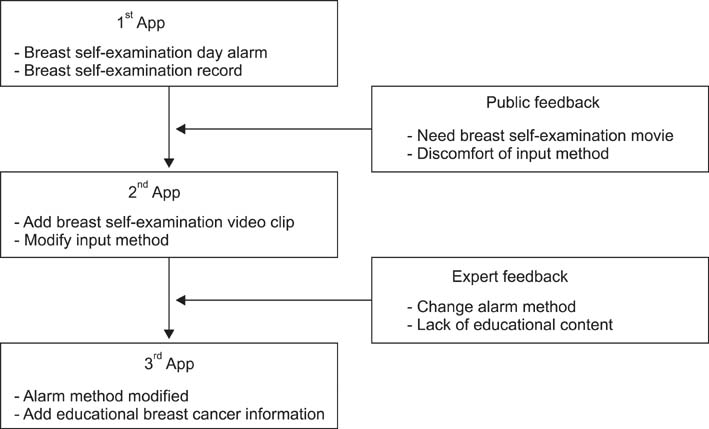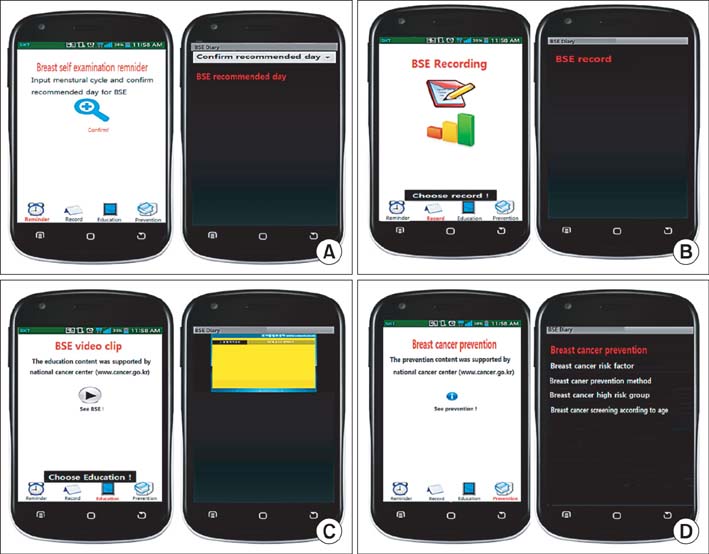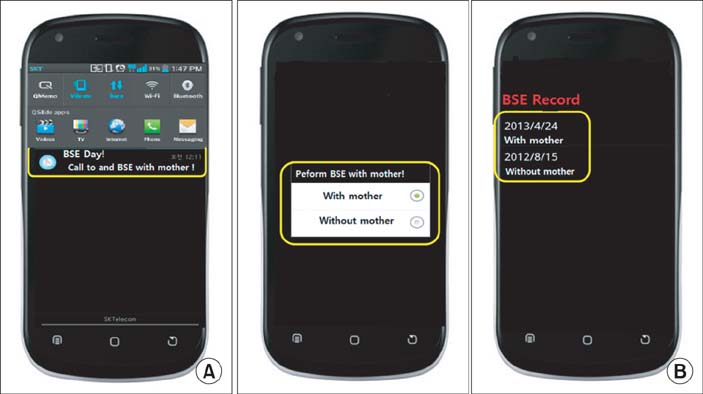Effects of a Smartphone Application on Breast Self-Examination: A Feasibility Study
- Affiliations
-
- 1Department of Radiation Oncology, Ajou University School of Medicine, Suwon, Korea.
- 2Department of Biomedical Informatics, Ajou University School of Medicine, Suwon, Korea. veritas@ajou.ac.kr
- 3Center for Clinical Epidemiology and Biostatistics/Department of Biostatistics & Epidemiology, Perelman School of Medicine at the University of Pennsylvania, Philadelphia, PA, USA.
- 4Center for Pharmacoepidemiology Research and Training, Perelman School of Medicine at the University of Pennsylvania, Philadelphia, PA, USA.
- KMID: 2229500
- DOI: http://doi.org/10.4258/hir.2013.19.4.250
Abstract
OBJECTIVES
The aims of this study were to develop a smartphone application to encourage breast self-examination (BSE), and to evaluate the effects of this application in terms of modifying BSE behavior.
METHODS
A smartphone application, based on the Android OS, was developed with functions including a BSE date alarm, a reminder to encourage mother and daughter to practice BSE together, record keeping, and educational content with video clips. Females aged 19 and over were enrolled to evaluate the effectiveness of the application. Two series of questionnaires were carried out (before and after use of the application) by e-mail, telephone, and face-to-face interviews between July and September 2012.
RESULTS
Forty-five subjects were enrolled in the study (age 29.5-5.9 years). Of the participants, only 28 (62.2%) had ever practiced BSE and only one of these (2.2%) was carried out at the appropriate time, based on the results of the baseline survey. After using the application, the number of participants practicing BSE increased from 28 to 32 (62.2% to 71.1%, p = 0.503). In subgroup analysis (age < 30 years), the number of participants using BSE increased from 8 to 18 (36.4% to 81.8%, p = 0.002), and the number of those using it at the appropriate time rose from 1 to 15 (2.2% to 33.3%, p < 0.001).
CONCLUSIONS
The use of the developed smartphone application increased BSE in females younger than 30 years. To confirm the long-term benefits of the mobile application, additional studies must be carried out.
MeSH Terms
Figure
Cited by 4 articles
-
Development of Smartphone Educational Application for Patients with Coronary Artery Disease
Min Jung Cho, Jae Lan Sim, Seon Young Hwang
Healthc Inform Res. 2014;20(2):117-124. doi: 10.4258/hir.2014.20.2.117.Social Media in Clinical Practice
Mona Choi
Healthc Inform Res. 2015;21(2):138-140. doi: 10.4258/hir.2015.21.2.138.Usages of Computers and Smartphones to Develop Dementia Care Education Program for Asian American Family Caregivers
Jung-Ah Lee, Hannah Nguyen, Joan Park, Linh Tran, Trang Nguyen, Yen Huynh
Healthc Inform Res. 2017;23(4):338-342. doi: 10.4258/hir.2017.23.4.338.Predictors of Breast Self Examination Practice among North Korean Immigrant Women
Mi Yeul Hyun, Hyo Jeong Song, Eun Joo Lee, Seong Chul Hong, Sung Yob Kim, Chang Hyun Lee
Korean J Health Promot. 2015;15(1):9-15. doi: 10.15384/kjhp.2015.15.1.9.
Reference
-
1. Jemal A, Bray F, Center MM, Ferlay J, Ward E, Forman D. Global cancer statistics. CA Cancer J Clin. 2011; 61(2):69–90.
Article2. Jung KW, Park S, Kong HJ, Won YJ, Lee JY, Seo HG, et al. Cancer statistics in Korea: incidence, mortality, survival, and prevalence in 2009. Cancer Res Treat. 2012; 44(1):11–24.
Article3. Shin KR, Park HJ, Kim M. Practice of breast self-examination and knowledge of breast cancer among female university students in Korea. Nurs Health Sci. 2012; 14(3):292–297.
Article4. Leong SP, Shen ZZ, Liu TJ, Agarwal G, Tajima T, Paik NS, et al. Is breast cancer the same disease in Asian and Western countries? World J Surg. 2010; 34(10):2308–2324.
Article5. Son BH, Ahn SH, Lee MH, Park SK, Kim SW. Korean Breast Cancer Society. Hereditary breast cancer in Korea: a review of the literature. J Breast Cancer. 2008; 11(1):1–9.
Article6. Korea Breast Cancer Society. Breast cancer facts & figures [Internet]. Seoul, Korea: Breast Cancer Society;c2008. cited at 2008 Oct 1. Available from: http://www.kbcs.or.kr/journal/file/2006_2008_Breast_Cancer_Facts_and_Figures_updated.pdf.7. Koibuchi Y, Iino Y, Takei H, Maemura M, Horiguchi J, Yokoe T, et al. The effect of mass screening by physical examination combined with regular breast self-examination on clinical stage and course of Japanese women with breast cancer. Oncol Rep. 1998; 5(1):151–155.
Article8. Oh DK, Shim JI, Han M, Kim Y, Lee HY, Jun JK, et al. Breast cancer screening in Korean women: report of the national cancer screening program in 2008. J Breast Cancer. 2010; 13(3):299–304.
Article9. Yoo BN, Choi KS, Jung KW, Jun JK. Awareness and practice of breast self-examination among Korean women: results from a nationwide survey. Asian Pac J Cancer Prev. 2012; 13(1):123–125.
Article10. Loh SY, Chew SL. Awareness and practice of breast self-examination among Malaysian women with breast cancer. Asian Pac J Cancer Prev. 2011; 12(1):199–202.11. Rosmawati NH. Knowledge, attitudes and practice of breast self-examination among women in a suburban area in Terengganu, Malaysia. Asian Pac J Cancer Prev. 2010; 11(6):1503–1508.12. Yavari P, Pourhoseingholi MA. Socioeconomic factors association with knowledge and practice of breast self-examination among Iranian women. Asian Pac J Cancer Prev. 2007; 8(4):618–622.13. Ferris DG, Golden NH, Petry LJ, Litaker MS, Nackenson M, Woodward LD. Effectiveness of breast self-examination prompts on oral contraceptive packaging. J Fam Pract. 1996; 42(1):43–48.14. Khokhar A. Short text messages (SMS) as a reminder system for making working women from Delhi Breast Aware. Asian Pac J Cancer Prev. 2009; 10(2):319–322.15. Korea Internet and Security Agency. Survey on the wireless Internet usage [Internet]. Seoul, Korea: Korea Internet and Security Agency;c2012. cited at 2012 Feb 28. Available from: http://isis.kisa.or.kr/board/index.jsp?pageId=040000&bbsId=7&itemId=795&pageIndex=1.16. Chomutare T, Fernandez-Luque L, Arsand E, Hartvigsen G. Features of mobile diabetes applications: review of the literature and analysis of current applications compared against evidence-based guidelines. J Med Internet Res. 2011; 13(3):e65.
Article17. Holtz B, Lauckner C. Diabetes management via mobile phones: a systematic review. Telemed J E Health. 2012; 18(3):175–184.
Article18. Lim S, Kang SM, Shin H, Lee HJ, Yoon JW, Yu SH, et al. Improved glycemic control without hypoglycemia in elderly diabetic patients using the ubiquitous healthcare service, a new medical information system. Diabetes Care. 2011; 34(2):308–313.
Article19. Liang X, Wang Q, Yang X, Cao J, Chen J, Mo X, et al. Effect of mobile phone intervention for diabetes on glycaemic control: a meta-analysis. Diabet Med. 2011; 28(4):455–463.
Article20. Song TM, Ryu S, Lee SH. u-Health service for managing chronic disease: a case study on managing metabolic syndrome in a health center in South Korea. Healthc Inform Res. 2011; 17(4):260–266.
Article21. Free C, Knight R, Robertson S, Whittaker R, Edwards P, Zhou W, et al. Smoking cessation support delivered via mobile phone text messaging (txt2stop): a single-blind, randomised trial. Lancet. 2011; 378(9785):49–55.
Article22. Sreedharan J, Muttappallymyalil J, Venkatramana M, Thomas M. Breast self-examination: knowledge and practice among nurses in United Arab Emirates. Asian Pac J Cancer Prev. 2010; 11(3):651–654.23. Moore JO, Hardy H, Skolnik PR, Moss FH. A collaborative awareness system for chronic disease medication adherence applied to HIV infection. Conf Proc IEEE Eng Med Biol Soc. 2011; 2011:1523–1527.
Article24. Kidd CD, Breazeal C. Robots at home: understanding long-term human-robot interaction. In : Proceedings of the IEEE/RSJ International Conference on Intelligent Robots and Systems; 2008 Sep 22-26; Nice, France. p. 3230–3235.25. Héry C, Ferlay J, Boniol M, Autier P. Changes in breast cancer incidence and mortality in middle-aged and elderly women in 28 countries with Caucasian majority populations. Ann Oncol. 2008; 19(5):1009–1018.
Article26. Korea Information Society Development Institute. Smart device usage and lifestyle of retirement age [Internet]. Gwacheon, Korea: Korea Information Society Development Institute;c2013. cited 2013 Mar 25. Available from: http://www.kisdi.re.kr/kisdi/fp/kr/publication/selectResearch.do?cmd=fpSelectResearch&sMenuType=2&controlNoSer=43&controlNo=13124&langdiv=1.27. Knutson D, Steiner E. Screening for breast cancer: current recommendations and future directions. Am Fam Physician. 2007; 75(11):1660–1666.28. Haji-Mahmoodi M, Montazeri A, Jarvandi S, Ebrahimi M, Haghighat S, Harirchi I. Breast self-examination: knowledge, attitudes, and practices among female health care workers in Tehran, Iran. Breast J. 2002; 8(4):222–225.
Article
- Full Text Links
- Actions
-
Cited
- CITED
-
- Close
- Share
- Similar articles
-
- The Development and Application Effects of a Fatigue Self-Care Smartphone Application for Lung Cancer Patients Receiving Chemotherapy
- Development of a Smartphone Application Prototype for Child Obesity Prevention: Rationale and Study Design of Acceptability and Feasibility Tests
- Smartphone Use Patterns of Smartphone-dependent Children
- Effects of Academic Stress in Middle School Students on Smartphone Addiction: Moderating Effect of Self-esteem and Self-control
- The Effects of Smartphone Application to Educate Patient on Patient Safety in Hospitalized Surgical Patients






